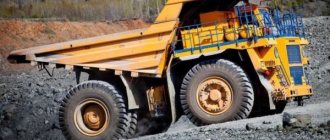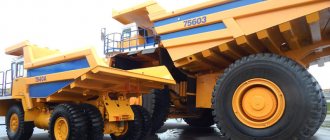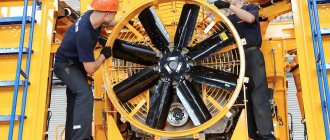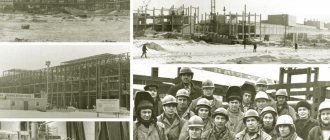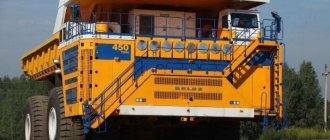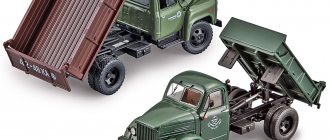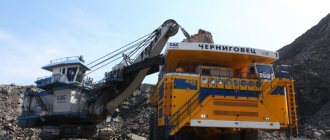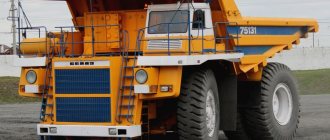Mining trucks are the highest form of technical art in automotive engineering. Cars must be powerful, reliable, and (yes!) beautiful! And the first-born of the Belarusian Automobile Plant met all these parameters: the car was created with inspiration. Further developments by the factory workers only confirmed that the BelAZ 540 has become a model for the qualitative growth of the plant and the creation of new models in the future. Some of the solutions that were used to build the car are still used by Belarusians today. Of course, the systems have become more complex, they are equipped with electronics and other improvements, but they are simple - the basic principles that make it possible to create such equipment are successfully used to this day.
Specifications
| BelAZ-540 | |||
| Manufacturer: | Belarusian Automobile Plant. | ||
| Years of production: | 1965-75 | ||
| Assembly: | BelAZ | ||
| Class: | Heavy duty. | ||
| Length: | 7250 mm. | ||
| Width: | 3480 mm. | ||
| Load capacity: | 27000 kg. | ||
| Weight in running order: | 20925 kg. | ||
| Total weight: | 48000 kg. | ||
| Base: | 3550 mm. | ||
| Minimum ground clearance: | 475 mm. | ||
| Tire size: | 18,00-25 | ||
| Fuel consumption: | 100 l/100km. | ||
| Maximum speed: | 55 km/h. | ||
| Engine: | BelAZ-540 A: YaMZ-240, diesel, V-shaped, four-stroke, twelve-cylinder | ||
| Engine capacity: | 22.3 l | ||
| Compression ratio: | 16.5 | ||
| Maximum power: | 360 hp | ||
| Compression ratio: | 16.5 | ||
| Main gear: | Central, single and planetary gearboxes in wheel hubs | ||
| Steering gear: | Two-stage: screw-nut on circulating balls and rack-toothed sector; with hydraulic booster | ||
Engine
The 540th model was equipped with a 12-cylinder four-stroke diesel engine D-12A (tank V-2).
Since 1967, the four-stroke V-shaped unit of the Yaroslavl Motor Plant YaMZ-240 appeared on the 540A model. Naturally aspirated with 12 cylinders with a volume of 22.3 liters, with a power system consisting of low and high pressure pumping units.
Fuel consumption has decreased from 125 liters to 100 per 100 km run, and lubricant consumption has significantly decreased. Unification with Yaroslavl engines 236 and 238 models created conditions for more efficient operation of the YaMZ-240.
The cooling system of a diesel engine operating in loaded mode consists of water and oil radiators of a six-row design, blown by two powerful fans.
Rear axle
The mechanism is made according to the traditional scheme for trucks:
- bevel gearbox of the final drive;
- differential built into the driven gear;
- two bevel type gears;
- planetary wheel gears.
Suspension
The dump truck uses hydropneumatic suspension for the front and rear axles. The front beam is equipped with 2 cylinders, travel limiters and a set of longitudinal and transverse rods. The rear suspension includes 2 cylinders, longitudinal bars and an additional fork. The rods perceive the forces transmitted by the axle to the frame.
The pneumatic-hydraulic cylinder includes a piston-type gas spring, a hydraulic shock absorber and a valve system. Compressed nitrogen is used as gas.
Transmission and steering
Transmission - hydromechanical; number of gears - 3+1, single main gear and planetary gearboxes in the wheel hubs. The power transmission also became an innovation in the Soviet automobile industry. It uses an intermediate three-shaft overdrive gearbox to drive the torque converter, the torque converter itself, a hydromechanical gearbox and a cardan to the drive rear axle.
Steering is facilitated by hydraulic booster. GIR – divided type. The GIR pump is powered into the common hydraulic system, from which the body lift pumps are also powered. In case of an unscheduled engine stop, there is a backup option for driving the pumps; it is carried out from the driving wheels of the truck. The steering mechanism is two-stage: a screw-nut on circulating balls and a rack-and-gear mechanism.
The torque converter is single-stage, equipped with two reactor wheels with aluminum blades. The gearbox is 3-speed, on two shafts, with friction gear shifting. To enable any mode, oil is transferred through a pump using a spool mechanism, from a mechanical drive on the steering column, to the required clutches. The torque converter softens the load and increases the service life of the chassis. The rear axle of the car is ordinary: with planetary gearboxes transmitting movement to the wheels and a single main gear.
Brake system
The braking system is pneumatic with drum brakes on the wheels. The device consists of:
- compressor:
- pneumatic cranes;
- receivers;
- brake pneumatic cylinders;
- service brakes of wheels with drive;
- parking brake on the secondary shaft of the box.
A pair of flaps in the engine exhaust pipe is used as a retarder.
Electrical equipment
The electrical circuit is built according to a 1-wire circuit, with the negative terminals of the battery and consumers connected to the car body. The dump truck used 4 batteries connected in pairs. When the engine is turned on, the voltage source is an alternating current generator working in conjunction with a relay regulator.
The most powerful consumer of electricity is the starting system of the power unit. Starter power is 15 hp. (for D12A engine) and 9.5 hp. (for YaMZ-240). The dump truck has several electric motors used to drive pumps and fans of the heating system. The car is equipped with headlights, sidelights, direction indicators and taillights.
King of the Gas Station
The layout of the BelAZ-540 was made according to the “cabin next to the engine” scheme. This scheme allows you to obtain a minimum base and length of the machine, and therefore increase its maneuverability. The same scheme makes it possible to rationally distribute weight along the axles and make the best use of the vehicle's area - most of the chassis is occupied by the body. These basic principles are still relevant today for “compact” mining vehicles.
And the BelAZ-540 was impressively large. For its time, of course. Make allowances for the fact that it was the most load-bearing Soviet dump truck at that time. That’s why they liked to photograph it next to cars to emphasize its scale.
Here and below, scanned historical photos from the author’s collection are used as illustrations.
BelAZ-540 became a star in the Soviet media space. His photographs constantly appeared in many newspapers and magazines. And Belarusian documentary filmmakers made an absolutely gorgeous film about how the first BelAZ-540 was assembled. The background music alone is worth it! Nowadays they don’t know how to shoot like that anymore.
Almost immediately, the BelAZ-540 became a movie star, playing one of the main roles in the cult comedy “Queen of the Gas Station.” This film featured one of the prototypes, testing of which began in 1962 - the same time the film was filmed.
- Gas station attendant! Refueler! Crap! Sleeping at work! Girl! Refuel!
- Don't shout. If you are rude, you will get nothing at all.
- Tsits!
- No, it’s you who is “tsyts”, please!
- They put some wicks here. Where are you looking? Where are you looking? Either the police are playing on your nerves, or else... You should be spraying with a spray bottle in a hairdresser. Hey you little fiend!
- Uncle! Uncle! Uncle, what about the money? Uncle! You have to pay...
- Lyudmila, come here!
- What?
— How many liters did you take?
— 370.
- I warned you. Well, little fish, now we’ll deduct it from your salary. According to the instructions. But tears cannot cover the shortage.
Obviously, the BelAZ-540 was added to the film for effect. Of course, such cars were not supposed to drive on public roads and refuel with diesel fuel at regular gas stations. On the one hand, the creators of the film did not confuse anything with the displacement: the fuel reserve of the BelAZ-540 was 400 liters, so it could easily carry 370. However, there was still a technical glitch: a reserve of 400 liters is the volume of two fuel tanks, and Lyudmila only poured diesel fuel into one of them. However, this does not make “Queen of the Gas Station” any less masterpiece.
The BelAZ-540 did not go into production immediately, but still quite quickly by Soviet standards.
Line development
With all the advantages of the 540th model, the operation of the truck revealed a number of problems that require solutions in subsequent modifications:
- Improving the ergonomic parameters of the cabin.
- Improving the efficiency of suspensions.
- Selection of materials and components for hydromechanical transmission and pneumatic-hydraulic suspension with a service life common to the machine.
- Optimizing the design of components, reducing the weight of mechanisms, increasing their reliability.
- Formation of a number of unified mechanisms and components in the line of BelAZ dump trucks.
- Search for new layout solutions to reduce loads on the frame and other components.
The next production model was the 40-ton BelAZ-548. Together with the Yaroslavl Motor Plant, the 75-ton BelAZ-549 with a fundamentally new type of electric drive “motor-wheel” was developed and put into production. The traction motor and planetary gearbox were built into the wheel hub. In the power unit, engineers tried to replace the “diesel-generator” pair with a “gas turbine-generator”. The experiment was considered unsuccessful due to increased fuel costs.
By 1985, the plant was producing units with a lifting capacity from 30 to 120 tons. The digital indices were changed - model 540 became designated as 7510, 540A became 7522.
By the end of the decade, a new model range appeared with 80-, 110-, 120-, 180-ton loading and an electric “motor-wheel” drive, unit indices 7549, 7519, 7512, 75214.
In the 90s, the basic vehicles were BelAZ-57131 with a load of 130 tons and a power plant consisting of a 1,600 hp Cummins diesel engine. pp., aggregated with a generating device, and a fifty-five-ton BelAZ-7555 with a Yaroslavl diesel engine of 730 liters. With.
In the summer of 2014, the open-pit BelAZ-75714, capable of transporting 450 tons of rock mass, began technological transportation in the open-pit mines of the Chernigovets coal mine.
In the Kuznetsk coal basin (Kuzbass), about 50 BelAZ trucks with a load of 320 and 360 tons are effectively operated. Service and assembly centers have been created, and the production of bodies and hydraulic equipment has been localized.
The BelAZ-540 mining vehicle was in use for several decades. Reliability, durability, good technical parameters and reasonable price made the unit the main means of mechanizing the removal of rock mass from open-pit mines in the 60s and 70s of the 20th century. The car was repeatedly awarded with diplomas and medals at Soviet and foreign car exhibitions, and was awarded the All-Union Quality Mark. The truck became the basis for the development of the entire model range of BelAZ mountain transport.
Price and reviews
Production of the equipment ceased more than 30 years ago, so there are no new machines on sale. Used cars are also not found on sale, since in the Soviet era, mining dump trucks exhausted their service life and were written off as scrap metal. The vehicle was not delivered to the army; the equipment does not exist in storage. For the same reason, it is impossible to rent a model 540 truck. The rental price of a BelAZ dump truck manufactured after 2000, which has a similar payload capacity, is 2-3 thousand rubles per hour.
For connoisseurs of scale replicas, there is a model of the car from Start Scale Models, painted in green-gray. The cost of a dump truck is up to 7.5 thousand rubles.
Alexey, Chelyabins, 40 years old
At the beginning of his working career, he worked for several months at BelAZ-540. The equipment worked non-stop, shutting down only to change oil and technical fluids. There were only a few warm boxes for maintenance. The car cabin is cold and noisy. The steering is power-assisted, but turning the wheel is still difficult.
Layout
The designers managed to significantly reduce the dimensions of the BelAZ compared to the Maz-525, while simultaneously increasing the carrying capacity (27 tons versus 25). The dump truck turned out to be one meter shorter, and the wheelbase was 1.2 meters shorter. This significantly reduced the turning radius. The weight of the truck is 20 tons. For the first time, a single-seat cabin shifted to the left of the engine compartment was used. The body received a more rational bucket shape. Thanks to a more “knocked down”, “dense” layout, the dump truck turned out to be maneuverable and productive: the weight of the cargo being transported exceeded the weight of the vehicle itself.
Cardan transmission
The transmission driveshaft connects the power plant and the boost gearbox. The mechanism compensates for the axial movement of the transmission and engine.
Structurally, it is designed as an elastic fastening joint, a universal joint on needle-type bearings, and a splined device consisting of two sliding flanges. The driveline device of the bridge consists of a pair of hinges connected by a spline joint. The shaft changes in length as the bridge moves relative to the main frame.
Reference sample prepared for shipment to the Leipzig fair, 1966
Reference sample prepared to be sent to the Leipzig fair, 1966
Reference sample prepared to be sent to the Leipzig fair, 1966
The appearance of the dump trucks was designed by artist-designer Valentin Kobylinsky, who previously worked at NAMI. This work can rightfully be considered one of the world achievements in the field of industrial aesthetics. Here’s how Kobylinsky’s contemporaries assessed it: “An element of asymmetry was boldly introduced - the cabin is shifted to one side, and the walkway with a handrail is shifted to the other. Such a balanced element of asymmetry softens the powerful form, and its plasticity becomes richer and more expressive thanks to the alternation of rich shadows and light.” (Y.S. Somov, “Composition in technology”)
History of creation
The history of the creation of the car begins in 1948. The post-war period is characterized by great poverty and devastation. At that time, the state actively began to extract minerals, as this was considered one of the ways to develop the economy. A plant was built in the city of Zhodino. For a long time the plant stood still and did not work. 1958 was a turning point for BelAZ, as technology and production of dump trucks with a load capacity of 25 tons were transferred from the Minsk Plant. During this period, production began to expand, and the vehicle's carrying capacity was already 40 tons.
After the load capacity mark of 40 tons, the automobile plant began to be nominated for various awards, even at the international level. This significantly influenced the manufacturer’s motivation and the quality of the products. 1969 marks the release of a 75-ton unit, which breaks all records with absolute certainty. Nine years later, in 1978, BelAZ produced a vehicle with a carrying capacity of 110 tons. The BelAZ-75211 modification eventually produced a truck that can lift up to 170 tons.
The BelAZ-7540 modification is one of the most successful. The car is one of the best in the world in its class. Year of manufacture: 1992. The amazing combination of a small car with incredible performance amazed the whole world. The model is designed to transport cargo exclusively in a quarry from the mining site to processing stations or product storage areas.
Tank engine for peaceful purposes
The first engine for the BelAZ 540 was the 12-cylinder v-shaped diesel “D-12” with a power of 375 hp. at 1650 rpm - a redesigned V-2 tank engine. The engine volume was 22.3 liters, the compression ratio was 16.5. In 1967, they began installing a new YaMZ-240 unit on the machine with 360 horses, released at 2100 rpm. These cars received the index “A” to their name. Both propulsion systems allowed the car to reach speeds of up to 55 km/h, versus 30 km/h for its predecessor. The fuel tank is designed for 400 liters of diesel fuel. Fuel consumption was consistent with the size of the car and the appetite of the engine: 100 liters per 100 km, but this was 25 liters less than that of the MAZ 525.
For effective cooling of components and assemblies, two six-row radiators blown by fans are installed: for water and oil. In many spare parts, the engine was unified with the YaMZ-236 and YaMZ-238, which made it easy to repair at that time - there were enough spare parts, due to the popularity of the two mentioned engines.
Chief designer Zalya Lvovich Sirotkin, under whose leadership the dump truck was created
Chief designer Zalya Lvovich Sirotkin, under whose leadership the dump truck was created
Chief designer Zalya Lvovich Sirotkin, under whose leadership the dump truck was created
Initially, the idea was not expressed as clearly as it appeared on the 1965 production dump trucks.
Suspension
The suspension is the main feature of the first Soviet mining dump truck. It consists of four independent hydropneumatic systems that ensure smooth operation. The systems consisted of a pneumatic piston with a hydraulic shock absorber and a plunger pump. During development, the designers used several unique proprietary developments that made the BelAZ a truly innovative vehicle.
Mining dump truck BelAZ-540
Modifications of BelAZ-7540
The BelAZ-754O family of 30-ton trucks includes four modifications, which differ from each other both in engines and the capacity of their bodies, as well as in overall dimensions. The 754OA and 754OB have identical dimensions: length - 7.11 m, width along the mirrors - 4.56 m, height along the visor - 3.93 m. Modification 7540E is slightly longer - 7.16 m and lower 3.9 m. Version 754OK is the longest of all existing in the enterprise’s production program - 7.41 m.
- 7540A - with a diesel engine YaM3-24OPM2, power of 309 kW and torque of 1491 N*m, at 16OO rpm. Transmission formula: 5+2. The geometric volume of the body is 15.1 cubic meters, with a 2:1 “head” - 17.8 cubic meters.
- 7540B – with diesel engine YaM3-24OM2, power 265 kW and torque 1275 N*m, at 16OO rpm. Transmission formula: 3+1. The geometric volume of the body is 19.2 cubic meters, with a 2:1 “head” - 21.7 cubic meters.
- 7540E – with a coal-carrying body, the car is equipped with a YAM3-24OM2 engine, with a power of 265 kW and a torque of 1275 N*m, at 16OO rpm. Transmission formula: 3+1. The geometric volume of the coal-carrying body is 24.7 cubic meters, with a “cap” of 2:1 – 28.2 cubic meters.
- 7540K - with a Cummins QSM11-C diesel engine with a power of 298 kW and a torque of 1898 N*m, 1ZOO-14OO rpm. Transmission formula: 5+2. The geometric volume of the body is 15.1 cubic meters, with a “head” of 2:1 – 19.2 m3. A number of 7540D modification dump trucks were also produced, equipped with a German-made Deutz BF8M1015 diesel engine with a power of 395 hp.
